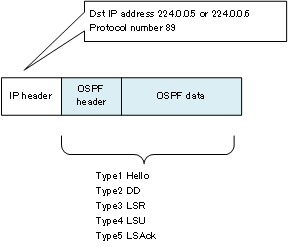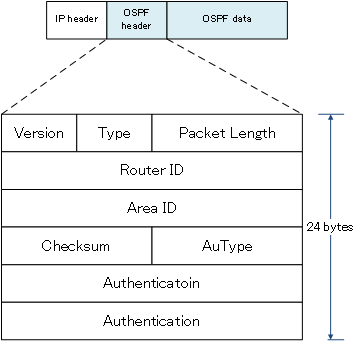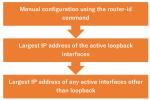Table of Contents
OSPF Packet Type
OSPF uses multiple OSPF packets to perform more advanced operations than RIP. OSPF packets are encapsulated in IP and exchanged between routers. The protocol number in the IP header is 89. The OSPF packets exchanged by OSPF routers are of the following types

| Type | Packet type |
| 1 | Hello |
| 2 | DD(Database Description) |
| 3 | LSR(Link State Request) |
| 4 | LSU(Link State Update) |
| 5 | LSAck(Link State Acknowledgement) |
Hello packet
Hello packets are used for dynamic discovery and maintaining of neighbors.
Related article
The details of Hello Packet are explained in the following article.
DD packet
DD packets are used to synchronize the link state database; they contain the LSA header part contained in their own LSDB.
Related article
Details of DD packets are explained in the following article.
LSR packet
LSR packets are packets that request the missing LSAs recognized in the exchange of DD packets.
LSU packet
The LSU packet sends the LSA requested by the LSR. LSU packets contain LSAs.
LSAck packet
LSAck packets are used to confirm the reception of LSU packets.
OSPF header format
The format of the 24-byte OSPF header that is commonly added to OSPF packets is as follows

Version
Version (8 bits) is the OSPF version; the OSPF version for IPv4 is “2”.
Type
The Type (8 bits) indicates the type of OSPF packet as described above.
Packet Length
Packet Length (16 bits) is the combined length of the OSPF header and the OSPF data portion.
Router ID
The Router ID (32-bit) is a 32-bit identification number that identifies an OSPF router.
Related article
For more information about OSPF router IDs, please see the following article
Area ID
Area ID (32 bits) is the area number to which the OSPF enabled interface belongs.
Checksum
Checksum (16 bits) to perform error checking.
AuType
AuType (16 bits) indicates the type of authentication.
| AuType value | Type of authentication |
| 0 | No authentication |
| 1 | plaintext password |
| 2 | MD5 |
Authentication
Authentication (64 bit) is the data used for authentication.
How the OSPF works
- OSPF Overview
- OSPF process flow
- OSPF Router ID : Identify OSPF routers
- What if the router ID of the OSPF router is duplicated?
- OSPF Neighbor and Adjacency
- OSPF DR/BDR
- How show ip ospf neighbor looks on Ethernet
- OSPF Network Type : Classification of OSPF-enabled interfaces
- Synchronization process of OSPF LSDB
- Problems with large-scale OSPF network
- OSPF Area – Inside the area, in detail; outside the area, just a summary
- OSPF Router Type
- OSPF LSA Type
- OSPF Area Type
- OSPF Basic Configuration and Verification Commands
- Details of enabling OSPF on the interface
- OSPF Advertising Loopback Interface
- Configuring and Verifying OSPF Hello/Dead interval
- OSPF Cost Configuration and Verification
- Configuring and Verifying OSPF Router Priority
- Configuring OSPF Neighbor Authentication
- Neighbor Authentication over Virtual-link
- OSPF Configuring and Verifying Stub area [Cisco]
- OSPF Stub Area Configuration Example [Cisco]
- OSPF default route generation : default-information originate command
- Configuration Example of OSPF default route generation : stub area
- OSPF Virtual-Link : Virtual area 0 point-to-point link
- Configuring and Verifying OSPF Virtual-link [Cisco]
- OSPF Virtual-link Configuration Example [Cisco]
- OSPF Virtual-link for discontinuous backbone configuration example
- OSPF Route Summary and Configuration
- Cisco OSPF Route Summary Configuration Example
- OSPF Route Type Preference
- Why the OSPF neighbor state gets stuck in Exstart?
- OSPF packet type and header format
- OSPF Hello Packet
- OSPF DD(Database Description) Packet
- OSPF LSR(Link State Request) Packet
- OSPF LSU(Link State Update) Packet
- OSPF LSAck(Link State Acknowledgement) Packet
- Limitation of OSPF redistribution routes – redistribute maximum-prefix command
- Overview of LSA Filters for OSPF – Filter LSA Type 3/Type 5
- Configuration example of LSA type 3 filter
- Configuration example of LSA type 5 filter
- OSPFv3 Configuration Example [Cisco]
- Configuration Example of OSPFv3 Route Summary [Cisco]



